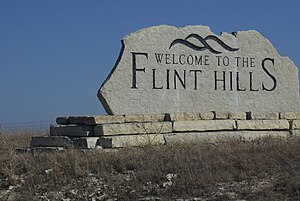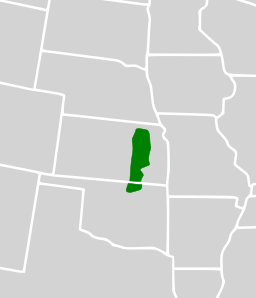Flint Hills tall grasslands
| Flint Hills | |
| Region | |
| Country | |
|---|---|
| States |
|
| Region | Great Plains |
| City | Manhattan, Kansas (largest) |
| Elevation | 512 m (1,680 ft) |
| Coordinates | 37°17′00″N 96°40′31″W / 37.28333°N 96.67528°WCoordinates: 37°17′00″N 96°40′31″W / 37.28333°N 96.67528°W |
| Length | 252 km (157 mi) |
| Width | 150 km (93 mi) |
| Area | 25,733 km2 (9,936 sq mi) |
| Biome | Temperate grassland |
| Geology | Permian Limestone |
| Plant | Tallgrass prairie |
| Bird species | 199 |
| Mammal species | 59 |
| Percent habitat loss | 24.3 |
| Percent protected | 2.68 |
|
Map of the Flint Hills ecoregion
|
|
| Website: Flint Hills Website | |
The Flint Hills historically known as Bluestem Pastures or Blue Stem Hills, is a region in eastern Kansas and north-central Oklahoma named for the abundant residual flint eroded from the bedrock that lies near or at the surface. It consists of a band of hills stretching from Kansas to Oklahoma, extending from Marshall and Washington counties in the north to Cowley County, Kansas and Kay and Osage counties in Oklahoma in the south, to Geary and Shawnee counties west to east. Oklahomans generally refer to the same geologic formation as the Osage Hills or "The Osage."
The Flint Hills Ecoregion is designated as a distinct region because it has the most dense coverage of intact tallgrass prairie in North America. Due to its rocky soil, the early settlers were unable to plow the area, resulting in the predominance of cattle ranches, which are in turn largely benefited by the tallgrass prairie.
The Flint Hills Discovery Center, a science and history museum focusing on the Flint Hills, opened in Manhattan, Kansas, in April 2012.
Explorer Zebulon Pike first coined the name the Flint Hills in 1806 when he entered into his journal, "passed very ruff flint hills". The underlying bedrock of the hills is a flinty limestone. The largest town in the area is Manhattan, Kansas, and the hills can be accessed from the Flint Hills Scenic Byway, which passes through in Kansas.
The rocks exposed in the Flint Hills were laid down approximately 250 million years ago during the Permian Period. During this time much of the Midwest, including Kansas and Oklahoma, were covered with shallow seas. As a result, much of the Flint Hills are composed of limestone and shale with plentiful fossils of prehistoric sea creatures. The most notable layer of chert-bearing limestone is the Florence Limestone Member, which is approximately 45 feet thick. Numerous roadcuts of the Florence Member are prominent along Interstate 70 in Riley County, Kansas. Unlike the Pennsylvanian limestones to the east, however, many of the limestones in the Flint Hills contain numerous bands of chert, or flint. Because chert is much less soluble than the limestone around it, the weathering of the limestone has left behind a clay soil with abundant chert gravel. Most of the hilltops in this region are capped with this chert gravel.
...
Wikipedia


